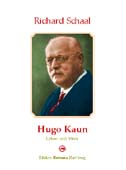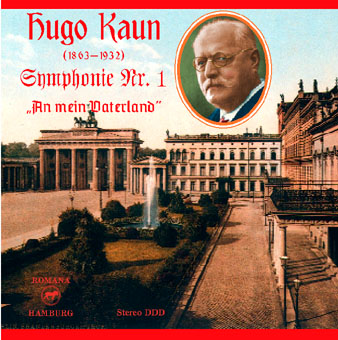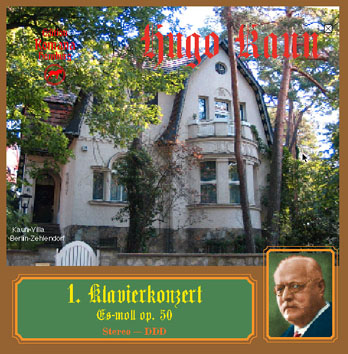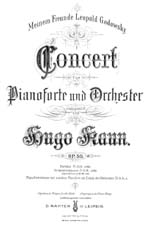![]() Hugo
Kaun
Hugo
Kaun![]()
21 March 1863 — 2
April 1932
Composer, conductor, choir conductor, piano teacher, professor.
Back to Index · Impressum · E-mail for ordering:
![]()
|
Kaun's "Maria Magdalena" is scheduled for 9 April 2010 with the Orchestra Society of Philadelphia under the direction of Kevin Scott:
http://orchestrasociety.org/schedule-current.php
|
|
|
Biography:
Wilhelm Ludwig Hugo Kaun was born on 21 March 1863 in Berlin-Friedrichshain, Blumenstrasse 34 a. In the town, near the Schlesischer Bahnhof (Silesian railway station, Eastern station) and the so-called Weberwiese (weaver's meadow) at the Frankfurter Tor, he spent his youth. The Weberwiese was a little peace of land, grown over with pines, and named after weavers, who lived about 1870 in a great number east of Berlin. Kaun's parents belonged to them. His mother was descended from the highly esteemed weaver family Kräutlein. His grandfather of his mother's side, who had come from Würzburg to Berlin was a guild master, but died only 42 years old. He was so respected that to his funeral came over 2000 weavers. Hugo Kaun's father Ludwig, born 3 Jan 1830 in Konitz (West Prussia, at the Tuchel Heath), went to Berlin and married Wilhelmine Kräutlein on 15 Sep 1862, by which he became a possessor of a weaver's business. In the address book of 1863 he was registered in the Blumenstraße 34 and in 1864 in the Blumenstraße 43 as a manufacturer of shawls and cloth. He cut a handsome figure, and the couple had pretty voices, which would have been honorable for each theatre. The mother, who was born Nov. 10, 1841, was descended from a line that migrated from Brandenburg. She was the second wife of Hugo Kaun's father. The couple had seven sons and one daughter, as well as one daughter from the first marriage of the husband. Of the sons (Hugo Kaun’s brothers) only three survived the first years: Richard, whose bass reached to the Contra-B flat, George, who built pianos at Bechstein, and Willy (William), who founded the William Kaun Music Co. in Milwaukee after having studied construction.
The Frankfort Gate in Berlin-Friedrichshain ca. 1750 |
At 13 years old in 1876, young Hugo visited the
Andreas Real high school. In the same year, Hugo
formed the plan to become a musician. The musical talents
of his parents may have been especially transferred
on the son. The musical inventions of the boy at that time
were already so many-fold, that Kaun had about 100 "compositions",
which he even dared to offer to an editor, as he
writes in his autobiography. The editor referred the
young man for the present to a profound teacher, the
conductor Neumann, a pupil of Friedrich Kiel. In
the meantime the resistance of the parents against the
son's desired profession had ceased, so that the
musician had no further obstacles. In
playing piano he had had no regular instruction up to his
16th year. When admitted to the Royal Academy of
music the 16 years old boy also got regular lessons in
this discipline. However, Kaun stayed at that institute
only a very short time, for his piano teacher Friedrich Grabau
could only be a real teacher for those who already had
the technical foundation in playing piano. In the
theory, Kaun had already learned the basics, what his
teacher Franz Schulz first tried to instruct his
pupils, and who therefore could not adjust for the widely
advanced Kaun. All those things weakened Hugo's
interest for the academy activities and he shirked the
institution. The expulsion from the university which
followed from this for Kaun meant only a liberation
from impediment chains. |
|
Looking for a suitable piano teacher he found Karl Raif, father of the great pedagogue Oskar Raif. But Karl was only to help Kaun as an excellent teacher for a short time, because he died after just one year of instruction. Then Oscar Raif tutored the young Kaun, who accepted the instruction of the experienced Oscar with enthusiasm, and under his care made quick progress. But alas, his hope to become a virtuoso was spoiled, for he sprained the third finger of the right hand. That was a hard fate for the pupil, for from now on he could no longer interpret his own works as before. That handicap was to become even more momentous in the future. As the piano instruction, which the 18 year old had to give for his livelihood, comprised nearly the whole day, for the reason of his study remained only a small part of the day, and as a theory pupil of Friedrich Kiel he felt that lack of time extraordinarily, because the excellent pedagogue stimulated Hugo to extensive works, which consumed Kaun’s time in evenings and night. Among his first works, in 1881 Kaun’s orchestra variations were performed by the orchestra of the Meisterschule of Music. The composer, who in the meantime was choir conductor (he had founded his "Kaunscher Gemischter Choir") with this work received the applause of his teachers, especially Philipp Spitta, the famous Bach biographer and at that time director of the Royal Music Academy. With this, the beginning of a very promising career had been made. |
In 1885 Kaun opened together with his brother Richard, who first of all had only sold fishes, a special musical shop in the east of Berlin.
After his father's death, who had suddenly died on his voyage as a mercantile agent in Silesia in 1886, he emigrated, 19 years old, in February 1887 to America, to make money. There he built up German choirs ("Milwaukee Liederkranz", "Milwaukee Männerchor") and after his poverty in the beginning, he built himself up as a composer, conductor and private teacher. On July 3, 1887 he married in Chicago the German Clara Friedrich, who already knew him from the Kaunscher Gemischter Choir in Berlin. In Milwaukee he got acquainted with the town music director Christoph Bach, who performed Kaun's music. As Kaun did not make much money, he then went to Chicago where he met Theodore Thomas, the world famous founder and conductor of the Chicago orchestra, and Bernhard Zien, the genial theorist, who caused a sensation in Germany with his harmony instruction and his downright astonishing book about canons.
By the performances finally achieved of his symphonic poems "Vineta" in Chicago (Adolf Rosenbecker) and Milwaukee (Christoph Bach) his name became more and more famous. On February 26, 1889 Kaun dared to rent the most beautiful and biggest theatre in Milwaukee, engaged the Bach orchestra (45 musicians) and performed a concert with only own compositions, what up to this date no one had dared to do. It was the first performance of that kind in America. For the first time were performed Kaun's overture "Christoph Marlowe", the symphonic Poem "Vineta", the first piano concerto in B flat minor (played by August Spanuth), string quartet variations and solo songs. In 1893 Theodor Thomas performed Kaun's first symphony in the Chicago Auditorium hall.
In 1902 he returned to Berlin where he occupied himself with his own works and composition instruction.
After a laborious life Hugo Kaun died on 2 April 1932. In honor of him on March 30, 1937 the Kaunstrasse in Berlin-Zehlendorf, where he had lived in a villa (no. 25) from 1902 to his death, was named.
To his works belong orchestra works as 3 symphonies, symphonic poems, 2 piano concertos, song pieces (also great operas) and numerous piano and other chamber music works. But especially famous he became with his eminent choirs.
His children were: Bernhard Kaun, Ella Kaun, Mary Kaun, Margaret Kaun, Martha Kaun
Kaun's third daughter Maria (10.7.1891 - 10.12.1975) founded and managed Amsel-Verlag in Berlin-Schlachtensee, which edited scores of Kaun's works.
For gratis download:
![]() Hugo Kaun, 1st
symphony, introduction (3 min., 1,45 MB). Under use of Gary
Garritan's “Garritan Orchestral Strings™”.
Hugo Kaun, 1st
symphony, introduction (3 min., 1,45 MB). Under use of Gary
Garritan's “Garritan Orchestral Strings™”.
![]() Hugo Kaun, Humoreske from op. 79 (piano 2hand.), beginning (330
kB), from the Kaun CD 1.
Hugo Kaun, Humoreske from op. 79 (piano 2hand.), beginning (330
kB), from the Kaun CD 1.
![]()
![]() New: Video clip about the composer's life, 18 min Youtube file now in HD (with German sound).
New: Video clip about the composer's life, 18 min Youtube file now in HD (with German sound).
![]() Video film on DVD about Hugo Kaun. With
many new details, new length now 21 min, with German sound, Euro
17,- + 2,- Port.
Video film on DVD about Hugo Kaun. With
many new details, new length now 21 min, with German sound, Euro
17,- + 2,- Port.
Books:
1) Aus meinem Leben, Erlebtes und Erlauschtes, Autobiography (only in German). Paperback, 96 pages, € 16 + 1.- € port.
 2) Richard Schaal,
Hugo Kaun, Leben und Werk (only in German). Paperback,
ca. 210 pages, Euro 25,-
2) Richard Schaal,
Hugo Kaun, Leben und Werk (only in German). Paperback,
ca. 210 pages, Euro 25,-
CDs:
 8) Hugo Kaun, works I: Pianoforte 2-h.:
Three pieces op. 56; Pianoforte 4-h.: 6 Compositionen op. 18;
Pianoforte + Cello: „Einsam“ ("Lonely") from
op. 103; Pianoforte, Violino, Cello: 2. Trio op. 58; Orgel:
Choralvorspiele op. 89; orchestra: „Idyll“ op. 60 Nr. 2.
First recording, € 12.- + port.
8) Hugo Kaun, works I: Pianoforte 2-h.:
Three pieces op. 56; Pianoforte 4-h.: 6 Compositionen op. 18;
Pianoforte + Cello: „Einsam“ ("Lonely") from
op. 103; Pianoforte, Violino, Cello: 2. Trio op. 58; Orgel:
Choralvorspiele op. 89; orchestra: „Idyll“ op. 60 Nr. 2.
First recording, € 12.- + port.
 23) Hugo Kaun, 1st
Symphony „An mein Vaterland“ (To
my Fatherland). Great heroic Symphony, componsed 1893 in
Milwaukee (USA) in the memory of his native country, first
performed 1889 by the Chicago Symphony orchestra under Theodore
Thomas, followed by many further performances. Duration ca. 40
min, first recording, € 12.00 + port.
23) Hugo Kaun, 1st
Symphony „An mein Vaterland“ (To
my Fatherland). Great heroic Symphony, componsed 1893 in
Milwaukee (USA) in the memory of his native country, first
performed 1889 by the Chicago Symphony orchestra under Theodore
Thomas, followed by many further performances. Duration ca. 40
min, first recording, € 12.00 + port.
 Hugo Kaun,
1st piano concerto e flat
minor op. 50, composed 1901, first performed 1905 in Berlin by
the pianist Vera Maurina (born Moscow 21 March 1876, died 15 Sept.1969
in New York). The work is dedicated to a friend of Hugo Kaun, the
piano virtous Leopold Godowsky (born 13 Febr.1870 near Wilna,
died 21 Nov. 1938 in New York). First
recording, € 12.00 + port.
Hugo Kaun,
1st piano concerto e flat
minor op. 50, composed 1901, first performed 1905 in Berlin by
the pianist Vera Maurina (born Moscow 21 March 1876, died 15 Sept.1969
in New York). The work is dedicated to a friend of Hugo Kaun, the
piano virtous Leopold Godowsky (born 13 Febr.1870 near Wilna,
died 21 Nov. 1938 in New York). First
recording, € 12.00 + port.
Port: EU 1-2 discs + € 4.50, USA 1
disc + € 4.- (air mail), 2-3 discs € 8.- (air mail).
Available from:
Gerhard Helzel. You can pay by Paypal.
The tree movements of the
concerto are superscribed: 
1. mov.: Nicht zu schnell, markig;
2. mov.: Ruhig, mit innigster Empfindung;
3. mov.: Sehr lebhaft, freudig erregt.
The beginning can above be downloaded gratis.
Orchestra music by Hugo Kaun:
I. Operas
1. Der Pietist (later “Oliver
Brown”), Libretto by Wilhelm Drobegg, Tragical Opera in one
act. Delivery by Richard Rühle, Berlin.
2. Sappho, musical drama in 3 acts (Libretto after Grillparzer's
tragedy). Wilhelm Zimmermann, Leipzig.
3. Der Fremde (The Stranger), phantastic opera in 4 pictures.
Libretto by Franz Rauch. Wilhelm Zimmermann, Leipzig.
4. Menandra, tragical opera in 3 acts. Libretto by Ferdinand
Jansen (under collaboration of Kaun). Joh. André, Offenbach a. M.
II. Symphonies
1. Symphony D minor, op. 22 “To my
Fatherland”. To the memory of my father. Edition: Rich.
Rühle, Berlin and Breitkopf & Härtel. Available
on CD.
2. Symphony C minor, op. 85, dedicated to Peter Raabe. Edition:
Ernst Eulenburg, Leipzig.
3. Symphony E minor, op. 96, dedicated to Robert Laugs. Edition:
Wilhelm Zimmermann, Leipzig.
III. Symphonic Works, Overtures and Suites for Orchestra
1. Vineta, symph. poem, op. 8. Rich. Rühle,
Berlin. Available on CD.
2. A Carnival festival, op. 21, Suite in 4 movements. Rich.
Rühle, Berlin. Also fourhanded.
3. Festival march using the American liberty hymn, op. 29. —
Also fourhanded. Rich. Rühle, Berlin.
4. In the Virgin Forest, op. 43, 2 symphonic poems after
Longfellow: a) Minnehaha, b) Hiawatha. Also fourhanded. Benjamin,
Hamburg. Available on CD.
5. Sir John Falstaff, op. 60, symphonic poem. To Theodor Thomas.
Ries & Erler, Berlin.
6. Six Original Compositions, op. 70, for small Orchestra. To
Traugott Ochs: a) Fröhliches Wandern, b) Walzeridyll (auf der 1.
Kaun-CD), c) Albumblatt, d) Variationen, e) Elegie, f) Rondo A-dur.
— Also twohanded, fourhanded, and for violine and
violoncello with piano acc. — Chr. Vieweg Söhne, Berlin-Lichterfelde.
7. Tree pieces for small orchestra, op. 76, to Felix Weingartner:
a) Scherzo, b) Nocturno, c) Intermezzo. Also twohanded,
fourhanded, and for violine and violoncello with piano acc.
— Chr. Vieweg Söhne, Berlin-Lichterfelde.
8. Maria Magdalena, Ouverture op. 44. To Wilh. Berger. C. F.
Kahnt, Leipzig.
9. At the Rhine, Ouverture, op. 90. Wilhelm Zimmermann, Leipzig.
10. Märkische Suite, op. 92 in 5 movements: a) Märkische Heide,
b) Rheinsberg, c) Kloster Chorin, d) Nachtgesang, e) Potsdam.
— a) b) c) for piano twohanded, e) also for organ. Wilh.
Zimmermann, Leipzig.
11. Hanne Nüfe, Ouverture, op. 107. Wilh. Zimmermann.
12. Juventuti et patriae, academic Ouverture, op. 126 Amsel-Verlag,
Berlin-Schlachtensee.
13. Suite “Menandra”. Joh. André, Offenbach a. M.
IV. piano and violino conzertos
1. Piano concerto e flat minor, op. 50, for
Leopold Godowsky. Benjamin, Hamburg. Available
on CD.
2. Piano concerto c minor, op. 115, for Max Chop. Joh. André,
Offenbach a. M. (burnt there).
3. Fantasy piece for violin and orchestra, op. 66. Dedicated to
Michael Preß. Rich. Rühle, Berlin.
V. Works for string orchestra
1. Three Bagatelles: a) Liebeslied, b)
Mondnacht, c) Menuett. Chr. Vieweg Söhne.
2. Album leaf, op. 70 Nr. 3. Chr. Vieweg Söhne.
3. Transscriptions from Joh. Seb. Bach’s works: a) Sarabande,
b) Bourree, c) Choralvorspiel „Erbarm dich Gott“, d)
Choralvorspiel „Aus tiefer Not“. Chr. Vieweg Söhne.
VI. Marches for orchestra
1. Festival march, op. 99, for great
orchestra. Wilh. Zimmermann.
2. Military march, also for piano twohanded; Trauermarsch,
Nächtlicher Zug op. 101. Wilhelm Zimmermann, Leipzig.
To this, nummerous songs (Lieder), choirs, piano and other chamber music works; from those very famous his oratorium "Mother Earth".
General index of the works of Hugo Kaun, PDF file 69 kB, for gratis download.
Dipl.-Ing. Gerhard Helzel, Timm-Kröger-Weg 15, D-22335 Hamburg, Tel. 040-505374
![]()
![]()
![]()